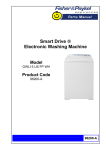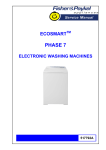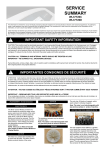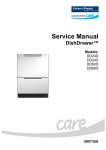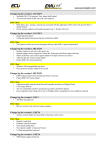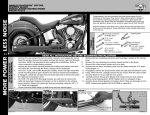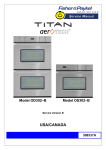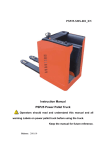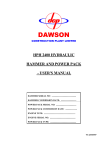Download Service Summary - 420600
Transcript
SERVICE SUMMARY GWL15 / IWL16 This information is intended for use by individuals possessing adequate experience in servicing electrical, electronic and mechanical appliances. Any attempt to repair a major appliance may result in personal injury and property damage. The manufacturer or seller cannot be responsible for the interpretation of this information, nor can it assume any liability in connection with its use. Cette information est destinée aux personnes possédant l’expérience requise pour réparer des appareils électriques, électroniques et mécaniques. Toute tentative de réparation d’un gros appareil comporte un risque de blessures à personnes et de dommages matériels. Le fabricant et le revendeur ne peuvent en aucun cas être chargés de l’interprétation de cette information, ni assumer aucune responsabilité en rapport avec son utilisation. CAUTION: This machine must be electrically grounded. It can be grounded through the grounding lead in the 3-prong power cord, if plugged into a properly grounded appliance outlet or through a separate No. 13 or larger wire from the cabinet to an established ground. In all cases the grounding method must comply with any local electrical code requirements. Certain internal parts are intentionally NOT GROUNDED and may present a risk of electrical shock only during servicing. Service personnel do not contact the following parts while the appliance is energised: Water Valve Brackets, Pump Mounting Bracket. To reduce the risk of shock, disconnect the power supply cord before servicing. CAUTION: ALL TERMINALS AND INTERNAL PARTS SHOULD BE TREATED AS LIVE. IMPORTANT – RE-CONNECT ALL GROUNDING DEVICES. If grounding wires, screws, straps, clips, nuts or washers used to complete a path to ground are removed for service, they must be returned to their original position and properly fastened. IMPORTANTES CONSIGNES DE SÉCURITÉ ATTENTION : Cette machine doit être mise à la terre. Elle peut l’être par le biais du conducteur de terre du cordon d’alimentation à prise de terre mâle, s’il est branché sur un point de réseau électrique correctement mis à la terre, ou par le biais d’un fil électrique épais séparé de l’appareil à la terre. Certaines pièces internes ne sont pas MISES A LA TERRE selon les normes internationales et peuvent présenter un risque d’électrocution durant l’entretien. Le personnel d’entretien ne doit pas toucher les pièces suivantes lorsque l’appareil est branché : les supports d’électrovanne et le support de montage de la pompe. Pour réduire le risque d’électrocution, le cordon d’alimentation doit être débranché avant tout entretien de l’appareil. ATTENTION : TOUTES COSSES DE CÂBLES ET PIÈCES INTERNES SONT À TRAITER COMME ÉTANT SOUS TENSION IMPORTANT – REBRANCHER TOUS LES DISPOSITIFS AVEC MISE À LA TERRE Si les conducteurs de terre, vis, barrettes, clips, écrous ou rondelles utilisés pour acheminer le circuit à la terre sont ôtés lors de l’entretien, ils doivent être solidement remis à leur place d’origine. PHASE 7 – A BRIEF OVERVIEW MOTOR CONTROL MODULE This module contains the circuits needed to control the water valves, pump, water level and rotation of the motor. The Pressure Sensor, used to detect the water level, is part of the Motor Control Module and cannot be removed. DISPLAY MODULE This receives the inputs from the front panel (i.e. User settings) and sends the appropriate command to the Motor Control Module. NOTE: Electrostatic Discharge Sensitive procedures should be observed for all electronic component handling. There are no field serviceable parts within the Motor Control Module or Display Module. MOTOR The motor is a 3-phase DC brushless motor. The Motor Control Module controls rotation of the motor. Note: The stator is not interchangeable with any previous phase or series of machine ROTOR STATOR The stator has 36 poles and the pole tips are curved. Between the Yellow and Blue connector the resistance will be 32Ω. The same resistance should be measured between the Blue and Red connector, and also the Yellow and Red connector. - 1 - The rotor has 16 blocks of magnets, which contain 3 individual magnets. Note: The rotor is not interchangeable with any previous phase or series of machine ROTOR POSITION SNSOR The rotor position sensor (RPS) is a printed circuit board that contains three Hall Sensors, which detect the magnetic field of the individual magnets in the rotor. The RPS provides this information to the Motor Control Module, which it uses to determine the position of the rotor. The printed circuit board sits in a plastic housing encapsulated by resin to protect the board. The only exposed area of the board is the connector for the main harness. WATER VALVES operate the machine with the lid in the open position the machine will stop and sound a warning tune. See user warnings 3. 4. 5. OUT OF BALANCE DETECTION Past electronic machines have used a lever connected to a mechanical switch to detect if the load in the inner basket is out of balance. On Phase 7 machines this system has been replaced with electronic sensing known as ‘Bump Detect’. ‘Bump Detect’ is software written into the Motor Control Module, which looks at specific feedback from the Rotor Position Sensor. No fault codes are associated with ‘Bump Detect’, and there are no hard and fast tests that can be carried out. If a machine continually goes into an out of balance condition then the following needs to be checked in the order given. 1. Even distribution of the clothes load. 2. Ensure that the machine is both level and stable on the floor. 3. Check the weight of the inner basket (23.10lb +/- 9.7oz / 10.48kg +/- 275g). 4. Check the RPS Note: If the OOB problem persists after checking the above, we would then recommend replacing both the suspension rods and the rotor. It is highly unlikely that the Motor Control Module will be the cause. No Cold Water IWL16 - “I am not getting any COLD WATER” GWL15 - Cold LED flashing 1. Cold tap hasn’t been turned on. 2. Inlet hose screens may be blocked. 3. There may be a kink in the hose. 4. Inlet hoses connected to the wrong faucets. 5. Cold water exceeds recommended limits. 6. The flow rate of water may be too slow. LINT REMOVAL SYSTEM Water is supplied via two valves that feed into a common valve body. A thermistor is located in the outlet side of the valve which supplies information to the electronics so that a constant wash water temperature is achieved irrespective of the temperatures and pressures of the incoming hot and cold water. FLOATING BASKET During spin, the agitator and the basket have to be coupled together and turn as a single unit. In agitate, the agitator and basket have to be free to rotate independently. At the base of the basket is a flotation chamber. As the water level rises the basket will float. This action disconnects a clutch between the agitator and basket. The agitator and basket can now move independently. When the water is pumped out, the basket sinks down and re-engages, allowing the agitator and basket to turn as one unit. DRAIN PUMP The drain pump motor is attached to the base of the tub. The pump housing is an integral part of the tub. The pump can be accessed from the top, if the agitator and basket are removed, or from underneath the machine. DIVERTER VALVE A diverter valve is located underneath the tub. This directs the tub water to the drain hose or to the recirculation hose. The valve is on whilst the machine is filling and re-circulating the wash water. It is also turned on briefly at the beginning of the rinse cycle to allow the re-circulation hose to empty. A plastic cover is fitted to protect the valve from moisture. LIDLOCK This machine has a lidlock that will lock the lid closed when the machine is operating. The lid is closed for the entire cycle. If the user attempts to As a result of the agitator action, lint and wash water is drawn into the agitator stem and down to the base, where they are directed into the cavity between the basket and tub. The holes in the basket allow the wash water to flow back into the basket but prevent the lint from following. Lint is carried out with the waste water. OPTION ADJUSTMENT MODE The washer can be adjusted to operate under a number of different conditions. The feature is called OPTION ADJUSTMENT MODE. Features that can be controlled include: · Rinse Options · Number of End of Cycle warning beeps · Automatic Out of Balance recovery · Automatic water level adjustment · Softener rinse volume adjustment (See User Guide for details). USER FAULTS Incorrect installation or operation can cause user faults. The washer can detect these and alert the operator by a musical series of beeps and either displaying a warning on the screen or flashing an LED. These are also listed in the Use & Care Manual. Out Of Balance IWL16 - “My Load is OUT OF BALANCE” GWL15 – First rinse LED or Final Spin LED is flashing Refer to Out of Balance Detection as detailed above. No Hot Water IWL16 - “I am not getting any HOT WATER” GWL15 - Hot LED flashing Hot water supply is not hot enough to maintain the temperature you have selected. 1. Select a lower wash temperature. 2. Inlet hose screens may be blocked. - 2 - There may be a kink in the hose. Hot tap has not been turned on. Inlet hoses connected to the wrong faucets. No Faucets IWL16 - “I am not getting any WATER” GWL15 - Cold and Hot LEDs flashing 1. The faucets haven’t been turned on. 2. Inlet hose screens may be blocked. 3. The hoses may be kinked. 4. The drain hose is too low or the drain hose is pushed into the standpipe too far and the water is siphoning out of the machine. 5. The flow rate of the water is too slow. Overloaded IWL16 - “I am OVERLOADED” GWL15 - High water LED flashing The machine is overloaded and cannot agitate. 1. Begin removing items until the remaining ones can move freely, or select a higher water level. 2. Check the machine is not syphoning Too Much Detergent IWL16 - “I have TOO MANY SUDS” GWL15 - High water LED flashing The machine has a suds build up. (Too much detergent may have been used for the amount of soil in the load). 1. Wait for suds to dissolve (about 20 minutes). 2. Rinse clothes using a deep rinse. Lid Open IWL16 - “I can’t LOCK THE LID” GWL15 - Lidlock LED flashing Make sure the lid is closed. Press START PAUSE. MACHINE SIZE SETTING The machine size must be set into the machine memory if a Motor Control Module or Display Module has been changed. To set the size: 1. Turn the power on at the power point and off at the console. 2. IWL16 - Press and hold the FABRIC CARE button, then press the POWER button. This will present a set of options in the LCD screen. The LCD screen has within it a number of options. Push the Adjust button to highlight the 650mm (L) machine size. Pushing the POWER button will lock the size into the module’s memory. GWL15 – Press and hold the WASH TEMP UP button then press the POWER button. Press the SPIN SPEED UP button (the HOLD LED should be on.) 3. Press the POWER button to return to normal operation. IF A FAILURE OCCURS Machine Size Error Fault code #9 Most failures are diagnosed by the Diagnostic System. If a fault is detected, the operation of the machine will stop. A fault code will either appear on the LCD display screen, or by displaying a series of wash progress LED’s. A continuous beeping sound will also occur. If this happens: 1. 2. Remove the plug from the wall outlet for at least one-minute. Plug in and start the machine. If the condition recurs, use the Diagnostic Mode to determine the cause. DIAGNOSTIC MODE The washers are fitted with a diagnostic system designed to help test the machine and obtain information that will assist in locating a fault. The Diagnostic mode also incorporates tests for both the drain pump and the water valves. To Select DIAGNOSTIC MODE 1. Turn the power on at the power point and off at the console. 2. IWL16 - Press and hold the LIFECYCLES button and then the POWER button. The machine will give 2 short beeps and the LCD screen will go blank. Then press the LIFECYCLES button again. GWL15 – Press and Hold the WASH TEMP DOWN button and then press the POWER button. IWL16 One of three screens will now appear: · Warning Status · Machine Status · Fault Status You can scroll between these screens using the options up and down buttons. The Warning Status screen will display the last USER WARNING FAULT that occurred and will show at what part of the cycle it occurred. The machine size setting does not match that stored in the memory. See MACHINE SIZE SETTING above for corrective action. Diverter: This Indicates status of diverter valve Size: This indicates the size of the machine (all U.S. Machines are 650mm) T: This indicates the actual temp of the inlet chamber water. HVDC: This is for on line testing in the factory. Target: This indicates the temperature that has been selected. Drain Pump Test IWL16 – Press the FABRIC CARE button to turn the pump on and off. GWL15 – Press the REGULAR button to turn the pump on and off. Water Valve Test IWL16 – Press the HOW DIRTY DOWN button to turn the Cold valve on and off. Press the HOW DIRTY UP button to turn the hot valve on and off. GWL15 – Press the WASH TEMP DOWN button to turn the cold valve on and off. Press the WASH TEMP UP button to turn the hot valve on and off. DETAILED FAULT DESCRIPTIONS GWL15 To obtain the detailed fault description, firstly enter diagnostic mode (as described above). Then press SPIN SPEED UP or DOWN buttons until the HOLD and SLOW spin LED’s are on. The detailed fault code can now be read from the wash progress LEDs. See diagram below. For each LED that is on add the values together. The LEDs with the value ‘32’, ‘16’ and ‘1’ are on, therefore 32 + 16 + 1 = 49 Fault Code #49 is displayed 128 64 32 16 8 4 2 1 Pump Blocked Error Fault code #37 Machine has not drained out. Check that the pump is not blocked or that the drain hose outlet is not crushed or blocked or drain hose outlet is too high. (Maximum is 7 ft.) Pressure Tube Fault Fault code #39 The probable cause of this fault is that the pressure tube has become blocked, crushed or has fallen off. Basket Disengage Fault Fault codes #40 #47 The floating basket has not engaged even though the pressure sensor indicates that the tub is empty. Check that the clutch or the pressure tube is not blocked or crushed. Hot and/or Cold Water Valve Faulty Fault codes #48 #49 #50 Check that the valve harnesses have been connected correctly or valve is not open circuit. Diverter Valve Fault Fault codes The User Warning Faults are as follows: No Faucets Overloaded Out Of Balance Over Suds or water still in the machine during spin No Hot Water No Cold Water Agitate Overloaded IWL16 The Fault Status screen will display a code for the last fault that has occurred in the machine. It will also display how many cycles ago that the fault occurred, and at what part of the cycle. Some common fault descriptions are shown in the following columns, for full detailed fault code information refer to the Service Manual. See Detailed Fault Codes for servicing tips. The Machine Status screen displays the status of the diverter and the out of balance switch. It also displays the size setting of the machine, and the thermistor temperature. - 3 - # 51 #52 Wash water is not circulating correctly in the recirculation hose. Check that diverter valve is directing the water flow to the correct hose i.e. during filling the water should be directed to the recirculation hose. There should be no flow in the drain hose. Failure in the diverter valve could be due to blockage in the valve, a wiring fault or fault in the Motor Control Module. Check that there are no leaks in any of the hoses. Also check resistance of diverter valve. Rotor Position Sensor Error Fault codes #130 NOTE: There is still power to the components when the POWER button in the “OFF” state. Always unplug the power cord before commencing service work or disassembly. #131 2. To remove the lid, open it to the upright position and lift it clear. 3. Remove 2 screws from the rear of the console. The console can be removed to gain access to the Motor Control Module, Display Module and wiring. A faulty signal has been received from the Rotor Position Sensor. Check for bad connection on the harness between the Rotor Position Sensor and the Motor Control Module, or a faulty Rotor Position Sensor. NOTE: Modules removed from the machine for return must be protected from electrostatic damage while in transit by using the special package in which the spare parts were received. High Motor Current Fault codes #132 #133 The Motor Control Module has detected excess current in the motor. Check the motor harness, connectors and motor for shorts. Check the Rotor Position Sensor and harness for water, mechanical damage or corrosion. If all the above show no signs of fault then replace the Motor Control Module. Motor Stall Fault codes #136 The Motor Control Module has been unable to start the motor. Possible causes of this fault are faulty motor harness, faulty or jammed motor, seized bearings or seals, faulty Motor Control Module, faulty Rotor Position Sensor or harness. DISASSEMBLY 1. Make sure disconnected. power and water Removing Top Deck 4. Disconnect Display Module and remove the console. Disconnect all harnesses to the Motor Control Module. Remove the pressure tube. Remove the water valves to then slide the power cord out from the top deck. Remove the ground wire. Note: When replacing a Motor Control Module ensure that the pressure tube is clear of any water droplets before operating the machine on a fill cycle. If the basket is full of water drain the water then blow down the tube. 5. Remove two rubber buffers and screws from the front of the top deck. Removing the Basket 6. Unclip the bias spring from the front left suspension rod. Unclip the neck ring from the top of the tub. 7. Remove the fabric softener dispenser, unscrew the agitator retaining bolt and remove the agitator. 8. The basket may now be lifted clear. If the basket is not easy to lift clear, then remove the three-spline retaining screws and remove the driven spline off the shaft and lift out. Diverter Valve 9. If the valve is replaced, ensure that the plastic shield is not removed from the replacement part, and the clip is refitted to secure the hose to the tub. After Reassembly and Testing… If the machine is advanced to either rinse or spin whilst filling or re-circulating, it may take up to 3 minutes before the drain pump turns on. This time allows the diverter valve to cool down and direct the water flow to the drain hose. If further help is needed concerning this appliance in USA or Canada call: TOLL FREE 1 888 9 FNP USA (188 936 7872) Or write to: Fisher & Paykel Appliances Inc 5800 Skylab Road Huntingdon beach California, CA92647 USA Note: Specifications are subject to change without notice. are Part Number 420939 - 4 -





